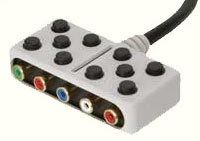Graphics Beginners' Guide, Part 1: Graphics Cards
Composite Video

This is the Composite Video jack, also known as RCA (Radio Corporation of America).
This is a traditional video output commonly used in televisions or related devices, such as VCRs. The video signal travels through a single, coaxial style jack. This will provide a very low-resolution analog signal that's typically used for presentations or gaming. It is not really suitable for reading anything because of the poor signal and image quality. It is, however, suitable for displaying standard definition video.
S-Video (a.k.a. S-VHS)

S-Video stands for 'Super Video" or 'Super VHS'.
S-Video is an analog video standard used by the television industry. It provides a low resolution signal to televisions like single-cable composite analog as all of the color information is in one signal, but breaks out luminance (brightness) and color. There are four pins and wires inside a standard S-Video cable with one for luminance, it ground, color and it corresponding ground. It allows for a higher-quality signal than single-cable composite-but still at a low dynamic resolution. However, while S-VHS is superior to single cable composite video, it is vastly inferior to high-quality component video (Y, Pb, Pr) outputs.
Component Video

Component outputs are too large to be on the graphics card itself and are usually accessed through a dongle. This dongle has both component video (the first three connectors) and audio (the last two connectors).
Stay on the Cutting Edge
Join the experts who read Tom's Hardware for the inside track on enthusiast PC tech news — and have for over 25 years. We'll send breaking news and in-depth reviews of CPUs, GPUs, AI, maker hardware and more straight to your inbox.
This output utilizes three separate coaxial style jacks, named "Y", "Pb" and "Pr". These provide separate color information for HDTV (high definition television). This type of output will also connect to most digital projectors. Although the signal is analog, it is a quality, separated, high-resolution signal like the VGA outputs provide. HD or high definition content can be delivered via component video
HDMI
HDMI stands for 'High Definition Multimedia Interface'
HDMI is the future standard. It is the only output that supports both video and audio information in the same cable. HDMI was created for television/movie applications, but because it is a highly secure format, computer users will require it to view upcoming high-definition content in high-resolution format.
HDMI connectors are still very scarce on video cards, but are expected to become much more common in the future. Viewing high-definition video on a PC may require both an HDMI video card as well as an HDMI-enabled monitor.
Current page: Composite Video
Prev Page The Basic Parts Of A Graphics Card Next Page Graphics Card Interfaces-
srinivasgtl Is it possible to get different output on different output ports on the graphics card? I want to play two different streams and use the two ports of the same graphics cards to display these streams on two different TV's. Is this possible?Reply
Most Popular

